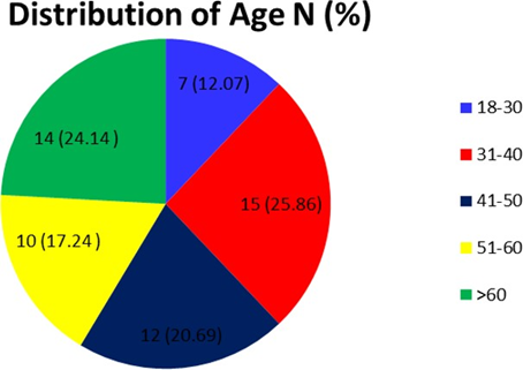Colonoscopic Profile of Lower Gastrointestinal Bleed in Adults: A Tertiary Care Centre Based Study
Abstract
Lower Gastro intestinal (LGIB) bleeding is one of the most important clinical symptoms which have significant morbidity and mortality. It has an annual admission rate of 0.15% with mortality rate of 5-10%. LGIB can be caused by a number of causes, including both neoplastic and non-neoplastic lesions. Colonoscopy is the gold standard diagnostic measure which is a simple, convenient and cost-effective procedure. The present study aimed to assess the Colonoscopic profile of LGIB presented to our tertiary care centre. This is a cross-sectional observational study conducted in a tertiary health care centre. A total number of 58 adult subjects with LGIB aged above 18 years were recruited over a period of six months after obtaining written informed consent. All included patients underwent detailed history, clinical examination, blood tests and colonoscopic evaluation. Results were analysed. In our study among the 58 subjects (n=33) were males, which were equal to 57%. The majority of our patients were between the mean age of 31-40 years. Most colonoscopic findings were suggestive of ulcerative colitis, which equalled to 31%. Other different aetiologies of LGIB were as following: carcinoma of the colon (15%), haemorrhoids (15%), colonic polyps (14%) carcinoma of anal canal (5%) and so on. The majority of our patients had moderate anaemia, which was equal to 45% and this was due to persistent LGIB. The incidence of lower GI bleeding increased with increasing age among our patients. The leading cause of lower GI bleeding was found to be ulcerative colitis. The prevalence of colon cancer increases with increase in age. It was followed by CA colon, haemorrhoids, and colonic polyps; hence colonoscopy is recommended in all patients with chronic LGIB.
Full text article
References
R J Hilsden and E A Shaffer. Management of gastrointestinal hemorrhage. Can Fam Physician, 41:1931–1941, 1995.
B Sahn and S Bitton. Lower Gastrointestinal Bleeding in Children. Gastrointest Endosc Clin NA, 26(1):75–98, 2016.
D M Jensen and G A Machicado. Diagnosis and treatment of severe hematochezia: The role of urgent colonoscopy after purge. Gastroenterology, 95(6):1569–1574, 1988.
A Kevin Ghassemi and D M Jensen. Lower GI bleeding: epidemiology and management. Curr Gastroenterol Rep, 15(7):333–333, 2013.
ASGE Standards Of Practice Committee, S F Pasha, A Shergill, R D Acosta, V Chandrasekhara, K V Chathadi, and D Early. The role of endoscopy in the patient with lower GI bleeding. Gastrointest Endosc, 79(6):875–885, 2014.
L L Strate and I M Gralnek. ACG Clinical Guideline: Management of Patients With Acute Lower Gastrointestinal Bleeding. Am J Gastroentero, 111(4):459–474, 2016.
A U Jehangiri, R Gul, R Hadayat, A N Khan, Zabiullah, and L Khursheed. Causes of lower gastrointestinal bleeding on colonoscopy. J Ayub Med Coll Abbottabad, 29(3):468–471, 2017.
G R Zuckerman and C Prakash. Acute lower intestinal bleeding. Part II: etiology, therapy, and outcomes. Gastrointest Endosc, 49(2):228–238, 1999.
A M Korkis and C J Mcdougall. Rectal bleeding in patients less than 50 years of age. Dig Dis Sci, 40(7):1520–1523, 1995.
E Qayed et al. Lower Gastrointestinal Hemorrhage. Crit Care Clin, 32(2):241–254, 2016.
N Zia, T Hussain, A Salamat, S Mirza, F Hassan, and A Waqar. Diagnostic evaluation of patients presenting with bleeding per rectum by colonoscopy. J Ayub Med Coll Abbottabad, 20(1):73–76, 2008.
F Joukar, S K Majd, A Fani, N Nazari, and F Mansour-Ghanaei. Colonoscopy outcome in North of Iran (Guilan): 2006-2009. Int J Clin Exp Med., 5(4):321–325, 2012.
S Bashir, R Nadeem, N R Khan, B A Suleman, and G R Qureshi. Histopathological analysis of 1000 colorectal biopsies in two years in shaikh zayed hospital, Lahore. Pakistan J Med Heal Sci, 6(1):115–117, 2012.
Authors

This work is licensed under a Creative Commons Attribution-NonCommercial-NoDerivatives 4.0 International License.





